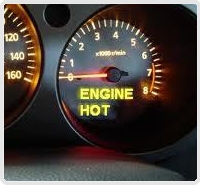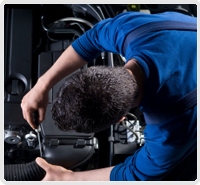|
The most recognisable part of the coolant system is the
radiator. It is connected to the engine with hoses and
is filled with coolant. The coolant draws heat off the
engine and then goes into the radiator. Air passes
through cooling fins to reduce the temperature of the
coolant and then it’s back to the engine again.
There are several ways for the cooling system to fail.
Most common is with the coolant itself. Coolant is a
mixture of water and antifreeze. The proper mixture
keeps the coolant from either boiling away or freezing.
Both of which can result in massive engine damage.
Another very important coolant issue that is often
overlooked is the age of the coolant itself. Antifreeze
has additives that protect the coolant system from
corrosion. As these additives are depleted over time,
they can’t protect the radiator and other parts from
rust, scaling and corrosion. Old coolant may still keep
your engine cool, but it won’t protect it from
corrosion.
If you see a warning message to check the coolant or if
the temperature gauge is in the hot zone your cooling
system needs to be checked so call our service centre
and we will advice you on what to do.
Water Pump Replacement
A properly operating water pump is a fundamental key to
your engine's survival. If your water pump is leaking at
the shaft, is wobbly, loose or noisy these are all
indications that a water pump replacement is required.
Your water pump keeps operating temperatures under
control and prevents boiling fluids from damaging your
cylinder head gaskets.
Most cars have the water pump mounted on the front of
the engine, with a drive pulley attached to the water
pump hub. A V-belt or a serpentine belt usually drives
the water pump pulley. Some front-wheel-drive vehicles
mounted the engine sideways, making belt access trickier
and occasionally require removal of the timing chain.
Radiator Hoses
Old radiator hoses or loose hose clamps can cause your
engine coolant to leak, which could lead to overheating
and expensive auto repairs. Have your radiator hoses
periodically and replace them if they appear aged or are
leaking coolant.

There are two hoses that attach to the radiator: an
upper hose at the top of the radiator and a lower hose
at the bottom. With the engine cold, squeeze each hose.
If the hose feels "crunchy" or brittle, it could need
replacing. Check the radiator hose clamps at either end
of both hoses. If the hose is damp or wet at the clamp,
tighten or replace the clamp. The clamps should be
tightened enough so that the radiator hose cannot be
turned or moved. Check the hose for cracks, tears, or
frayed ends. If you find any, replace the radiator hose.
Coolant System Flush
Service
This coolant absorbs heat from the engine and is flowed
by the water pump through hoses to the radiator. Once
the radiator transfers engine heat to the outside air,
the coolant circulates back to the engine and continues
the cycle.
To keep this important system properly working, vehicle
manufacturers recommend servicing it at specified time
or mileage intervals. The coolant’s rust inhibitors and
additives may lose their anti-corrosive properties,
leaving particles and debris in the system over time.
This can cause build-up within the radiator, reducing
its ability to keep the engine running at the optimal
temperature. To remove this build-up, we perform a
radiator flush service. By Doing a radiator flush we
remove all the old coolant and gunk and built-up that
there might be. Once the whole cooling system is empty,
we fill it back up with new radiator coolant and water
We can repair or replace
any of the following components
 |
Radiators |
 |
Radiator caps |
 |
Radiator hoses |
 |
Radiator fan or fan clutch |
 |
Thermostats & Water pumps |
 |
Fan belts and serpentine
belts |
 |
Temperature sensors |
 |
Heater cores |
|